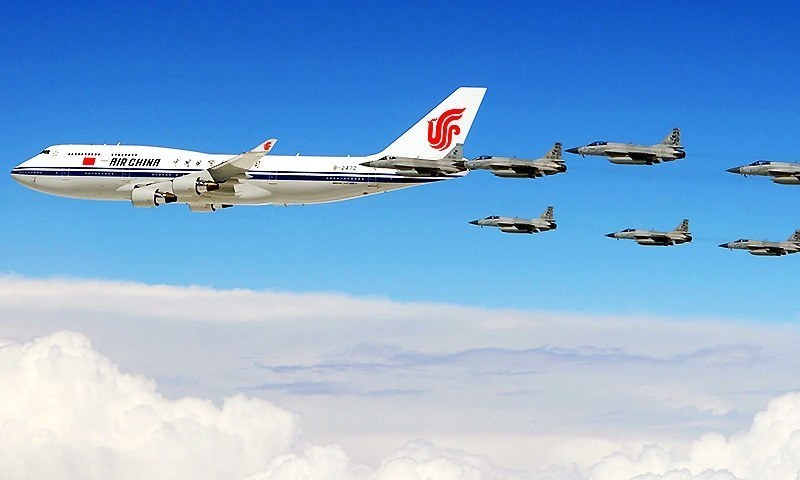No free Chinese lunch

THAT loud slurping you have been hearing this last fortnight is the sound of politicians, pundits and punters drooling over the prospect of $46 billion in Chinese investment coming to Pakistan.
Obviously, an impoverished country like ours can’t afford to look a gift horse in the mouth, especially if the horse in question is Chinese, and happens to be the only ride in town. ‘Game-changer’ is the expression most commonly being bandied about to describe the windfall. If we were to believe the TV anchors and their chat show guests, it’s as though we had hit the jackpot, and could all retire to Dubai.
For a dose of reality, just look what has happened in (and to) Sri Lanka with its spate of Chinese deals. The new government of President Sirisena is struggling to cope with the Chinese-financed and built projects it has inherited from the Rajapaksa administration.
The most contentious of these is the Colombo Port City with an investment of $1.35bn coming from the China Communications Construction Company, a huge government-controlled entity. This ambitious project — halted since the new government came to power earlier this year — is spread over 575 acres, part of which is to be reclaimed from the sea off Colombo’s shore.
Aimed at developing residential, entertainment and business spaces and facilities, the venture was designed to make Colombo a popular destination for tourists as well as a vehicle for investment in real estate. The problem is that the sponsors took many short cuts, ignoring important environmental requirements. Now if Sri Lanka cancels the deal, it stands to lose millions of dollars in penalties.
Several other public-sector projects funded and built by the Chinese are now lying virtually abandoned. Hambontota Port in the south is a case study in how to invest in useless infrastructure projects. When the new port was declared open about four years ago, a huge boulder was discovered in the channel that made navigation impossible. This obstruction was dynamited over months, but even now, it took a government directive to force car-carrying ships to dock there. Cars then have to be transported 250km to Colombo by road.
Who said China has got to where it is by handing out freebies?
Other Chinese-financed projects in the area include an international airport and a cricket stadium. Both are unused. A huge conference centre, financed by South Korea, is virtually derelict. The major users of the motorway around Hambantota are water buffaloes. One reason for all this ill-considered construction activity is that it happens to be in the ex-president’s constituency.
But to his credit, Rajapaksa focused on road-building, and there is now an excellent network in place. However, the huge difference in construction cost has raised many questions about transparency, especially about roads built with Chinese funding and by Chinese contractors.
For instance, the Southern Expressway connecting Colombo to Galle, financed by the Asian Development Bank and Japan, cost $7 million per kilometre. By contrast, the Outer Circular Highway connecting the airport to the Galle Expressway, financed by a Chinese loan and awarded without competition to a Chinese firm, is going to cost $72m per kilometre.
Of course, no two highways are identical and construction costs will vary depending on the soil conditions as well as the quality. But in an article in Colombo’s Sunday Times, Professor Kumarage, an experienced civil engineer, writing about these projects, informs us that:
“The common denominator of all these projects is that they were funded with Chinese borrowings and contracts have all been awarded in 2014 without calling for competitive bids. The loss arising from these four projects is estimated at 200 billion rupees [around $1.5bn].”
Fortunately, the $30bn dollar Chinese investment in the China-Pakistan Economic Corridor is not in the shape of loans as the project is designed for China’s benefit. By connecting Gwadar Port to western China, it will save millions every year in transport costs. It is not clear, however, if we will charge the Chinese transit fees for trucks and trains carrying their goods across our territory as we have been charging Nato.
The remaining $16bn are intended for the power sector in solar, wind and coal-fired projects whose total output will be 10,400MW, a welcome addition to our present installed capacity. However, this investment is subject to a 20pc matching investment from the private sector in Pakistan. But given the favourable conditions written into this tranche, I can see Pakistani businessmen queuing up to invest.
Consider: there is a guaranteed internal rate of return (IRR) of 18pc, and this is pegged to the dollar. So if the greenback is trading for Rs110 a couple of years down the road, we will be paying an extra 10pc in rupees. And presumably, Chinese contractors will be appointed without competition, so much of the investment will be recovered early if the contracts are front-loaded.
But hey, who said China has got to where it is by handing out freebies?
Published in Dawn, May 2nd, 2015
On a mobile phone? Get the Dawn Mobile App: Apple Store | Google Play